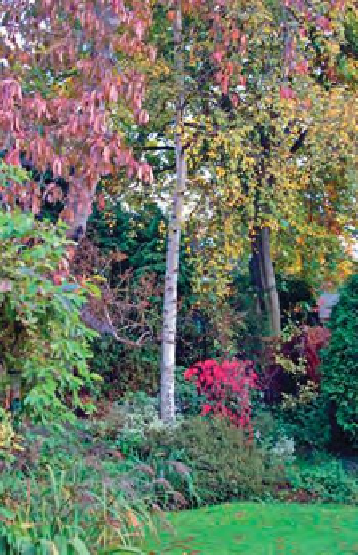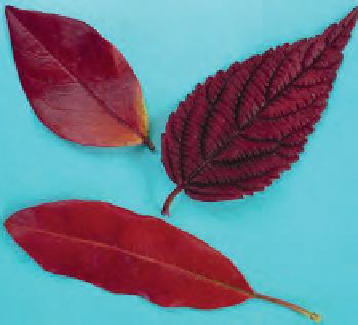Agriculture Reference
In-Depth Information
(a)
(b)
(c)
Figure 5.11
Autumn colour in (a)
Vaccinium
corymbosum
(blueberry); (b)
Viburnum
; and
(c)
Photinia,
showing loss of chlorophyll and
emergence of xanthophylls
of light, which determine the colour of the pigment.
In the actively growing plant, chlorophyll, which
reflects mainly green light, is produced in considerable
amounts, and therefore the plant, especially the
leaves, appears predominantly green. Other pigments
are present - for example, the carotenoids (yellow)
and xanthophylls (red) - but usually the quantities are
so small as to be masked by the chlorophyll. In some
species, such as
Fagus sylvatica
Purpurea Group
(copper beech), other pigments predominate, masking
chlorophyll. Many colours are displayed in the leaves
at this time in such species as
Acer platanoides
,
turning gold and red,
Prunus cerasifera
'Pissardii' with
light purple leaves,
Larix decidua
(European larch) with
yellow leaves,
Parthenocissus quinquefolia
(Virginia
creeper) and
Vitis
spp. with red leaves, beech with
brown leaves. Coloured autumn fruits are also prized
in the garden such as the berries in
Cotoneaster
and
Pyracantha
and the colouring of stems can become
more intense, such as in
Cornus
(dogwoods). These
are used in
autumn colour
displays at a time
when fewer flowering plants are seen outdoors
(Figure 5.12).
In deciduous woody species, the leaves drop in the
process of
abscission
, which can be triggered by
shortening of day length. To reduce risk of water loss
from the remaining leaf scar, a corky layer is formed
before the leaf falls.
In many
fruits
, ripening is associated with an increase
in respiration and changes in colour, sweetness,
Figure 5.12
Autumn interest in the garden: acers with
bright leaves, birch with silver bark and yellow leaves,
fl owering grasses, leaves and bark of
Eucalyptus
flavour, texture and scent. This is soon followed by
natural progression to a senescent stage in which the
fruit deteriorates and the seed ripens before it is shed,
although growers aim to harvest fruit before this stage
is reached and arrest further development through
a range of post-harvest techniques such as the use
of reduced temperatures. Eventually, senescence is
followed by
death
at the end of the season in annuals
or at the end of the plant's life in perennials (or death
of the plant organ such as a leaf where this undergoes
senescence). All metabolic processes cease and the
plant matter is returned to the soil to be taken up by
and to sustain future plants.
Further reading
Capon, B. (2005)
Botany for Gardeners
. Timber Press.
Cushnie, J. (2007)
How to Prune.
Kyle Cathie.
Ingram, D.S., Vince-Price, D. and Gregory, P.J. (2008)
Science and the Garden.
Blackwell Science.
Hodge, G. (2013)
RHS Botany for Gardeners.
Mitchell
Beazley.
Please visit the companion website for further information:
www.routledge.com/cw/adams





